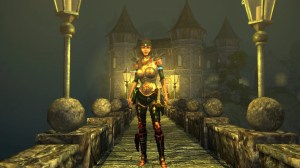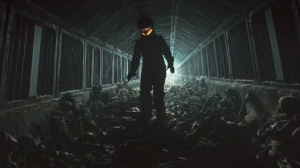
G.I. JOE has been a staple of American media since the original figure, one that reflected the multiple branches of the United States military, was first developed in 1963. The brand has grown and evolved significantly since that time, altering the scale of its figure and developing stories on film, television, and, most significantly, comics. It was the G.I. JOE: A Real American Hero series at Marvel Comics that first developed an expansive mythos for both the heroic Joes and their villainous counterparts in COBRA. Now, IDW Publishing is delivering a new starting point for a new generation of readers; this time G.I. Joe is a resistance organization fighting back against COBRA after they have seized control of the United States.
Videos by ComicBook.com
Both Michael Kelly, VP of Global Publishing for Hasbro, and John Barber, IDW’s editor-in-chief, spoke with ComicBook.com comic book reviews editor Chase Magnett to discuss the relaunch of G.I. JOE, the brand’s extensive history, and why G.I. JOE continues to be an essential and popular property after almost 60 years.
ComicBook.Com: Before digging into G.I. JOE #1 and any specifics on the new series, I wanted to look at the history of Hasbro and G.I. JOE comics. G.I. JOE: A Real American Hero in the 1980s took a popular brand and reinvented it, expanding on characters, narratives, and themes in a way that made the figures and comics a symbiotic success for many years. How do you conceive of the relationship between G.I. JOE and comics in 2019?
Michael Kelly: Generally speaking, we think of brands differently now than we perhaps did in the early 80s. It’s no longer about the comic vs. the toys vs. the movies etc.; there’s just G.I. JOE. It’s no more my job to use comics to sell action figures than it is for the toys or the movies to sell comics. Rather, it’s our collective job to make G.I. JOE one of the most exciting, interesting, and entertaining brands in the world. The relationship is one of considering the needs and wants of our fans, the value of great storytelling, and the history and future of G.I. JOE. Fans come to our brands through all different media. Some are collectors, some want to read a great comic, some love the films or TV, some just want to play with the toys. What is vital is ensuring that whatever access point they choose, they are getting the best we have to offer. If that inspires them to engage with different aspects of the G.I. JOE franchise, that’s fantastic. But if they only want to read a comic, it’s my job to make sure it’s the best possible G.I. JOE comic.
John Barber: From my point of view, G.I. JOE has always been a comic book. It was the first comic I read regularly—when I was a kid, I never thought of G.I. JOE as being different from any team that started in comics. And being lucky enough to work on it as a grown-up, I still feel the same way. Hasbro has always been a great partner on G.I. JOE—pushing us to explore these characters as characters, and putting them in new situations that reflect the world around us. I mean, that said, I love the toys. I have one of the newer Skystrikers looking down at my desk in my office at home and our publisher has one in his office here—we all love the toys! But I never felt like the comics were anything but a key part of G.I. JOE.

ComicBook: Now G.I. JOE #1 is presenting an accessible point for new readers and reinventing the familiar narrative in an interesting fashion. Would you provide an origin story on how this new series came to be behind-the-scenes?
Kelly: We’ve been talking about relaunching a G.I. JOE comic for quite a while now and went through a few different ideas. In the end, however, I wanted to create a story that was taken from the pages of history but could also inspire a new generation. In my ramblings, I came across information on Britain’s Special Operations Executive in WW2. I found this organization particularly intriguing because it recruited civilians, trained them in espionage, sabotage, and other deep cover skills, and dropped them into Nazi occupied Europe. These were shopkeepers, teachers, librarians, and laborers whose only common thread was their courage, ingenuity, and desire to fight for good over evil. Also unique for the time, both men and women were recruited into the SOE. Their actions in Europe are estimated to have shortened the war by as much as 6 – 9 months, saving countless lives. It sounded a lot like the kind of thing G.I. JOE would do: fight for freedom, wherever there’s trouble.
This became my inspiration for a new edition of G.I. JOE. A story of resistance and hope against enormous odds; a story about the indomitability of the human spirit.
Barber: Michael and I had talked about new takes on G.I. JOE literally for years, looking at different ways of taking their story; new ways of thinking about the characters and the core concept. When he outlined this one to me, I was really pulled in. There were so many possibilities, and it was such an exciting way to look at the characters while still staying true to the characters. One of the most appealing things about G.I. JOE for me is how distinct and unique each of the characters is—and this approach really put that in the foreground. They’re real people, with their own backgrounds and ways of looking at things, who have to come together for a greater cause. That’s pure G.I. JOE.
ComicBook: When did writer Paul Allor and artist Chris Evenhuis factor into those plans? What made them the best duo to deliver this relaunch and new angle on a classic franchise?
Barber: I’ve worked with Michael directly for eight years now, and he’s a great storyteller—that’s one of the real joys of working on these series is having somebody who’s really thinking about story, about being compelling to the readers and honoring the characters, and all of that was wrapped up in his idea. But there were still a million directions to go with it. We’ve got Larry Hama writing G.I. JOE: A Real American Hero and that series does a great job in telling stories with the classic G.I. JOE mix of military action, ninjas, and science fiction—so we knew this needed to be a different feel. Because why do the same thing we already have, right?

We reached out to a few people, and editor Bobby Curnow thought of Paul. Paul was perfect—he knows G.I. JOE inside and out, but he comes at stories in a really unique way. Partially it’s his focus on characters, and on how it feels to be in these situations—what it’s like to be a person going through these events—which is 1) when G.I. JOE is always at its best and 2) pretty literally what this series is about. Paul had a really grand-scale, interesting take on the world that would give rise to this G.I. JOE program, and his pitch really made the characters shine. There was big-picture and small moments together, which is a winning combination.
Chris and Paul have worked on a few comics together—they’re like a great band that always hits you with something new and exciting every album—and they actually first teamed up on a G.I. JOE short story a few years ago. Bobby pulled Chris into the mix, too—and what made Chris perfect is that he draws real people in real situations. Not every comic book artist can do that—Chris has a sense of the character’s personality and a way of drawing people where they’re like people you know… and then he can take that an put it into a more fantastic situation, where it doesn’t take away from the excitement but still maintains an emotional link—beyond just looking cool (which it also does).
ComicBook: And, from a critical perspective at least, I think it’s clear that Hasbro and IDW have been very successful in their partnerships so far. Transformers is one of the largest comics epics of the past decade (or more) and set a very high bar for comics expanding on licensed characters. Are their similarly expansive plans for the future of G.I. JOE?
Kelly: This is good opportunity to point out that Larry Hama’s run on G.I. JOE: A Real American Hero, is approaching its 275th issue. It doesn’t get much more expansive than that. And I’ve said this before, but it bears repeating: As long as Larry wants to keep writing Real American Hero, that story will continue. So fans of that series have nothing to fear.
And we will continue to experiment with new stories that focus on particular characters or particular missions. I’ve always been a fan of seeing how different writers and artists interpret our brands, and G.I. JOE is no exception. I’m excited to see Rob Liefeld’s work on Snake Eyes, and of course Tom Scioli’s work on G.I. JOE vs TRANSFORMERS was mind-bending (pun probably intended). Michel Fiffe’s Sierra Muerte was another exciting example of giving creators the space to bring their magic to the brand. I anticipate you will see more of this type of work as we move into the future.
Certainly my hope is that the new series will create its own universe of G.I. JOE as well, and I envision a time when we have spotlights and mini-series that can dive into depth with particular characters and side missions. Which is all a long way of saying yes, our plans are expansive.

Barber: I absolutely agree! This world is rich with possibilities—and I’m saying “world” very deliberately, because there’s stuff happening all over the planet, and in our first issues, we’ve only scratched the surface of what the G.I. JOE team is up against.
ComicBook: Focusing a little bit more on the direction of the new series, G.I. JOE has evolved through a lot of American history, changing with the mood, interests, and needs of the day. What about G.I. JOE #1 makes it stand out to you as the G.I. JOE that’s needed in 2019?
Kelly: I think the best stories reflect the times they are a part of. I think back to G.I. JOE in the early 80s, and it was a great stand in for the social and political issues of the time. The Cold War was in full swing, the Vietnam war had been over for less than 10 years. Whether accurate or not, there was a perception at the time that the world was evenly divided between two opposing ideologies. It was an anxious time, and there was plenty to worry about, but it felt very structured. You basically knew which side you were on, one way or another.
But I don’t think readers between the ages of 10 and 30 recognize a world that is so well defined, and that needs to be reflected in our storytelling. These days it’s easy to feel overwhelmed. Threats are totally asymmetrical, and our anxieties stem from countless sources. It’s common to not just feel anxious, but at times even helpless.
And that’s the world where this new G.I. JOE story fits in. It’s a story of everyday heroes rising up and taking a stand, and overcoming any feelings of helplessness. It’s exciting, and dramatic, and even funny at times, but at heart it is a story of hope and perseverance against incredible odds. I’m certainly not going to say I expect a G.I. JOE comic to change the world, but if it offers today’s audience either inspiration or escapism, like Real American Hero did in the 80s (and continues to offer still today), then we’ll have done our job.
Barber: The idea of normal people standing up for what’s right and protecting those around them, for standing tall and trying to change the world—that couldn’t resonate more, I think. The world is overwhelming, like Michael said—but there’s hope there, and G.I. JOE showcases that.
ComicBook: And to be a little more specific, the Joes in this series are framed as an insurgency fighting back against a dominant Cobra on American soil. What values does a more rebellious and resistant team of Joes provide for readers now, especially in comparison to their past roles as peacekeepers or defenders?
Kelly: One of the things that has always drawn me to G.I. JOE is the basic reality of it all. These are superheroes and supervillains, to be sure, but they don’t have superpowers. You hear the word “aspirational” from marketers a lot, but G.I. JOE is genuinely aspirational, because anyone can be a member of G.I. JOE. You don’t have to have been exposed to radiation, or come from another planet, or have a mutated DNA.. All you need is to push yourself in mind and body beyond your own expectations, to face your fears and conquer your doubt. There’s no magic here, just a persistence of will and an unwillingness to give up. G.I. JOE reflects the very best of humanity, and I think that will resonate with today’s readers. It’s easy to be the good guys when you are winning, but it’s under adversity that true heroes are made.

Barber: There’s always something compelling about the underdog. When I think of my favorite G.I. JOE stories when I was young, they’re usually when the team is overwhelmed (like when Cobra attacked the PIT, or the Joes stormed Cobra Island, or when they first encountered the Oktober Guard) or when it’s just Snake Eyes or a couple agents out on their own. This new series basically takes those scenarios and makes that the overarching set-up. The G.I. JOEs are always outnumbered, and always have to find the strength inside of them to confront Cobra.
ComicBook: Finally, since you both know a lot about what’s to come, I want to ask for both stalwart and new fans of the franchise: What has you most excited to see this series launch in September?
Kelly: Honestly, I’m most excited to see the reaction of readers and fans. I know of course there will be some who feel this isn’t the G.I. JOE they grew up with, and they may decide it’s not for them. But I hope they will give it a try, understanding the spirit in which it is presented, and knowing that Real American Hero will continue for them as well. After all, one thing I think we can all relate to is the wish to see G.I. JOE embraced and enjoyed by a new generation, and to give those new readers and fans an experience similar to what we older fans enjoyed in 1982. At the end of the day, I feel it’s our responsibility to keep G.I. JOE alive and vibrant and exciting for many years to come, so that in 2056 we will still be talking about it. By the way, I believe Real American Hero will be closing in on Issue 450 by then.
Barber: Paul’s first issue script was fantastic—and it was even better once Chris drew it, and better again when Brittany Peer colored it… then issue 2 was even better. And 3 was better than that… it’s amazing, because I really thought maybe they wouldn’t be able to top issue 1. So I’m most excited about the next issue, because every one adds to what’s come before and makes me understand the characters more, and see more of the world. Oh, and also I’m really excited to meet Destro in this world, and that comes really soon…
G.I. JOE #1 will be available for print and digital purchase on Wednesday, September 18th at comics retailers everywhere.








